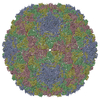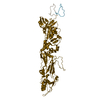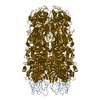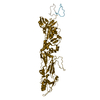+ Open data
Open data
- Basic information
Basic information
| Entry | Database: PDB / ID: 8egs | ||||||
|---|---|---|---|---|---|---|---|
| Title | Tail knob structure of Staphylococcus phage Andhra | ||||||
 Components Components |
| ||||||
 Keywords Keywords | VIRUS / phage tail | ||||||
| Function / homology | Distal tube protein, N-terminal / Caudoviral major tail protein N-terminus / Lower collar protein / Major tail protein Function and homology information Function and homology information | ||||||
| Biological species |  Staphylococcus phage Andhra (virus) Staphylococcus phage Andhra (virus) | ||||||
| Method | ELECTRON MICROSCOPY / single particle reconstruction / cryo EM / Resolution: 3.92 Å | ||||||
 Authors Authors | Kizziah, J.L. / Hawkins, N.C. / Dokland, T. | ||||||
| Funding support |  United States, 1items United States, 1items
| ||||||
 Citation Citation |  Journal: Sci Adv / Year: 2022 Journal: Sci Adv / Year: 2022Title: Structure and host specificity of bacteriophage Andhra. Authors: N'Toia C Hawkins / James L Kizziah / Asma Hatoum-Aslan / Terje Dokland /  Abstract: is an opportunistic pathogen of the human skin, often associated with infections of implanted medical devices. Staphylococcal picoviruses are a group of strictly lytic, short-tailed bacteriophages ... is an opportunistic pathogen of the human skin, often associated with infections of implanted medical devices. Staphylococcal picoviruses are a group of strictly lytic, short-tailed bacteriophages with compact genomes that are attractive candidates for therapeutic use. Here, we report the structure of the complete virion of -infecting phage Andhra, determined using high-resolution cryo-electron microscopy, allowing atomic modeling of 11 capsid and tail proteins. The capsid is a = 4 icosahedron containing a unique stabilizing capsid lining protein. The tail includes 12 trimers of a unique receptor binding protein (RBP), a lytic protein that also serves to anchor the RBPs to the tail stem, and a hexameric tail knob that acts as a gatekeeper for DNA ejection. Using structure prediction with AlphaFold, we identified the two proteins that comprise the tail tip heterooctamer. Our findings elucidate critical features for virion assembly, host recognition, and penetration. | ||||||
| History |
|
- Structure visualization
Structure visualization
| Structure viewer | Molecule:  Molmil Molmil Jmol/JSmol Jmol/JSmol |
|---|
- Downloads & links
Downloads & links
- Download
Download
| PDBx/mmCIF format |  8egs.cif.gz 8egs.cif.gz | 129 KB | Display |  PDBx/mmCIF format PDBx/mmCIF format |
|---|---|---|---|---|
| PDB format |  pdb8egs.ent.gz pdb8egs.ent.gz | 92.4 KB | Display |  PDB format PDB format |
| PDBx/mmJSON format |  8egs.json.gz 8egs.json.gz | Tree view |  PDBx/mmJSON format PDBx/mmJSON format | |
| Others |  Other downloads Other downloads |
-Validation report
| Summary document |  8egs_validation.pdf.gz 8egs_validation.pdf.gz | 1.2 MB | Display |  wwPDB validaton report wwPDB validaton report |
|---|---|---|---|---|
| Full document |  8egs_full_validation.pdf.gz 8egs_full_validation.pdf.gz | 1.2 MB | Display | |
| Data in XML |  8egs_validation.xml.gz 8egs_validation.xml.gz | 37.1 KB | Display | |
| Data in CIF |  8egs_validation.cif.gz 8egs_validation.cif.gz | 53.6 KB | Display | |
| Arichive directory |  https://data.pdbj.org/pub/pdb/validation_reports/eg/8egs https://data.pdbj.org/pub/pdb/validation_reports/eg/8egs ftp://data.pdbj.org/pub/pdb/validation_reports/eg/8egs ftp://data.pdbj.org/pub/pdb/validation_reports/eg/8egs | HTTPS FTP |
-Related structure data
| Related structure data |  28129MC  8egrC  8egtC  8ej5C M: map data used to model this data C: citing same article ( |
|---|---|
| Similar structure data | Similarity search - Function & homology  F&H Search F&H Search |
- Links
Links
- Assembly
Assembly
| Deposited unit | 
|
|---|---|
| 1 | x 6
|
| 2 |
|
| 3 | 
|
| Symmetry | Point symmetry: (Schoenflies symbol: C6 (6 fold cyclic)) |
- Components
Components
| #1: Protein | Mass: 28450.355 Da / Num. of mol.: 2 Source method: isolated from a genetically manipulated source Source: (gene. exp.)  Staphylococcus phage Andhra (virus) / Gene: Andhra_16 / Production host: Staphylococcus phage Andhra (virus) / Gene: Andhra_16 / Production host:  Staphylococcus phage Andhra (virus) / References: UniProt: A0A1S6L1H8 Staphylococcus phage Andhra (virus) / References: UniProt: A0A1S6L1H8#2: Protein | | Mass: 68431.773 Da / Num. of mol.: 1 Source method: isolated from a genetically manipulated source Source: (gene. exp.)  Staphylococcus phage Andhra (virus) / Gene: Andhra_12 / Production host: Staphylococcus phage Andhra (virus) / Gene: Andhra_12 / Production host:  Staphylococcus phage Andhra (virus) / References: UniProt: A0A1S6L1I1 Staphylococcus phage Andhra (virus) / References: UniProt: A0A1S6L1I1 |
|---|
-Experimental details
-Experiment
| Experiment | Method: ELECTRON MICROSCOPY |
|---|---|
| EM experiment | Aggregation state: PARTICLE / 3D reconstruction method: single particle reconstruction |
- Sample preparation
Sample preparation
| Component | Name: Staphylococcus phage Andhra / Type: VIRUS / Entity ID: all / Source: RECOMBINANT |
|---|---|
| Source (natural) | Organism:  Staphylococcus phage Andhra (virus) Staphylococcus phage Andhra (virus) |
| Source (recombinant) | Organism:  |
| Details of virus | Empty: NO / Enveloped: NO / Isolate: SPECIES / Type: VIRION |
| Natural host | Organism: Staphylococcus epidermidis |
| Buffer solution | pH: 7.8 |
| Specimen | Embedding applied: NO / Shadowing applied: NO / Staining applied: NO / Vitrification applied: YES |
| Vitrification | Cryogen name: ETHANE |
- Electron microscopy imaging
Electron microscopy imaging
| Experimental equipment |  Model: Titan Krios / Image courtesy: FEI Company |
|---|---|
| Microscopy | Model: FEI TITAN KRIOS |
| Electron gun | Electron source:  FIELD EMISSION GUN / Accelerating voltage: 300 kV / Illumination mode: FLOOD BEAM FIELD EMISSION GUN / Accelerating voltage: 300 kV / Illumination mode: FLOOD BEAM |
| Electron lens | Mode: BRIGHT FIELD / Nominal defocus max: 3500 nm / Nominal defocus min: 1000 nm |
| Image recording | Electron dose: 39 e/Å2 / Film or detector model: GATAN K3 (6k x 4k) |
- Processing
Processing
| Software | Name: PHENIX / Version: dev_4290: / Classification: refinement | ||||||||||||||||||||||||
|---|---|---|---|---|---|---|---|---|---|---|---|---|---|---|---|---|---|---|---|---|---|---|---|---|---|
| CTF correction | Type: PHASE FLIPPING AND AMPLITUDE CORRECTION | ||||||||||||||||||||||||
| 3D reconstruction | Resolution: 3.92 Å / Resolution method: FSC 0.143 CUT-OFF / Num. of particles: 101037 / Symmetry type: POINT | ||||||||||||||||||||||||
| Refine LS restraints |
|
 Movie
Movie Controller
Controller






 PDBj
PDBj